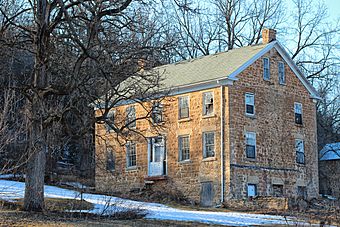Adam Dunlap Farmstead facts for kids
Quick facts for kids |
|
|
Adam Dunlap Farmstead
|
|

Part of the farmstead.
|
|
| Location | 9646 Dunlap Hollow Rd., Mazomanie (town), Wisconsin |
|---|---|
| Area | 5 acres (2.0 ha) |
| Architectural style | Greek Revival |
| NRHP reference No. | 01001242 |
| Added to NRHP | November 15, 2001 |
The Adam Dunlap Farmstead is a historic farm in Mazomanie (town), Wisconsin. A family from New York, the Dunlaps, built it. It was one of the very first farms in the area. Many of the original buildings are still standing. They were built around 1849 using stone from the farm itself.
This farmstead became a protected historic site in 2003. It was added to both the State and the National Register of Historic Places. It's special because it shows what a pioneer farm looked like. The main stone farmhouse also has a cool Greek Revival style.
Contents
History of the Dunlap Farm
Settlers started moving to the Mazomanie area in 1844. This was only twelve years after a big battle, the Battle of Wisconsin Heights, happened nearby. In 1846, Adam Dunlap and his family arrived. They began to build their farm on a hill. It overlooked a marsh next to what is now Dunlap Creek.
At that time, only about two dozen families lived in the whole area. The Dunlaps were from central New York state. They had Scottish roots. Adam was 32 years old. He came with his wife Harriet, their young children, and his parents, John and Nancy.
Building the Farmstead
First, the Dunlaps lived in a simple log cabin. After a few years, Adam hired a stonemason. This builder was from Honey Creek, Sauk County, Wisconsin. He helped build stronger, more lasting buildings. Most of these stone buildings are still standing today.
The main house is large and made of stone. It was built around 1849. It has 3.5 stories, including a basement that shows from the hillside. Its walls are very thick, built from stone blocks. These stones were dug up right on the farm. The walls are 2.5 feet thick at the bottom. They get a bit thinner towards the roof.
The house shows classic Greek Revival style. It has a gently sloped roof. There are decorative boards called frieze boards. The front door has special windows around it. These are called a transom (above the door) and sidelights (next to the door). All the windows are placed evenly, making the house look balanced.
Other stone farm buildings were also built around 1849. One barn that still stands is 34 by 40.5 feet. Its stone walls are 24 feet tall. It had stalls for about 21 dairy cows on the first floor. Above that, there was space for hay and grain.
Next to this barn are the remains of a much larger stone barn. It was 80 by 24 feet. This barn was built at the same time but sadly burned down in 1929.
There's also a stone ice house or spring house. The taller part was built around 1849. It is 14 by 16 feet. A lower section was added later, between 1890 and 1900. This building had a pipe that brought spring water. This water was likely used to keep milk, butter, and cheese cool. The foundation of the corn crib was also probably built around 1848. The wooden top part has been rebuilt since then.
Farm Life and Crops
The farm's first main crop was wheat. Wheat was very valuable back then. It grew well on the new farmland. Early settlers hoped the Wisconsin River would help them ship their crops. But the river was too shallow and had too many sandbars.
Luckily, in 1856, the Milwaukee and Mississippi Railroad started stopping in Mazomanie. This was only five miles away. Soon, flour mills and creameries opened there. This gave the Dunlaps a good place to sell their crops.
Adam was a hard worker. His farm grew quickly. By 1860, he grew more wheat than any other farm in the area. Records from 1850, 1860, and 1870 show how the farm changed. Adam tried different crops and types of animals.
| 1850 | 1860 | 1870 | |
|---|---|---|---|
| Acres | 120 | 240 | 250 |
| Farm Cash Value | $100 | $3,000 | $10,000 |
| Value of Implements | $60 | $195 | $1,000 |
| Value of Stock | $225 | $985 | $950 |
| Horses & Oxen | 4 | 6 | 4 |
| Milk Cows | 6 | 8 | 7 |
| Butter produced (pounds) | 700 | 800 | |
| Cheese produced (pounds) | 100 | ||
| Other Cattle | 5 | 25 | 17 |
| Sheep | 24 | 100 | 100 |
| Swine | 0 | 15 | 6 |
| Wheat (bushels) | 460 | 300 | 840 |
| Corn (bushels) | 100 | 1,000 | 450 |
| Oats (bushels) | 125 | 200 | 800 |
| Barley (bushels) | 0 | 200 | 0 |
The Dunlap Family Legacy
Adam and Harriet had ten children in total. Six of them lived past infancy. Harriet passed away in 1883. Their son John and his family lived with Adam for several years. John died in 1888.
Then, another son, Ervin, and his family moved in. They helped Adam run the farm until Adam died in 1901. Ervin's son, Guy, and his family took over in 1909. They continued to farm until the 1960s.
Guy's daughter, Dorothy Dunlap Szudy, owned the farm until 1997. After she passed away, her husband Leonard owned it. Their son Lenny and his family lived in the house. The Dunlap family has a private cemetery near the house. Adam, Harriet, Adam's parents, Dorothy, and other relatives are buried there.

